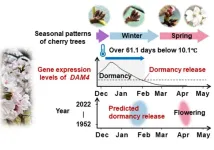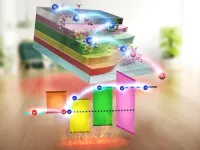(Press-News.org)
Samarium (Sm), a rare earth metal, is important to organic chemists because of the ability of its divalent compounds to efficiently perform single-electron transfer reductions. Samarium iodide (SmI2) is moderately stable and can operate under mild conditions at room temperature, making it highly useful for producing pharmaceuticals and biologically active materials. However, most reactions require SmI2 in quantities equal to or greater than the stoichiometric amount and necessitate the use of harmful chemicals, making the process resource-intensive and expensive to manage.
Several approaches have been studied to reduce the amount of Sm reagents to catalytic amounts. However, most of the currently available methods require harsh conditions and highly reactive reducing agents and still require significant amounts of Sm, typically 10–20% of the raw materials. Considering the high cost of Sm, there is a significant demand for an efficient catalyst system that uses minimal Sm under mild conditions.
In a recent breakthrough, a research team from Chiba University in Japan, led by Assistant Professor Takahito Kuribara from the Institute for Advanced Academic Research and the Graduate School of Pharmaceutical Sciences, developed an innovative method that significantly reduces the amount of Sm. The team developed a 9,10-diphenyl anthracene (DPA)-substituted bidentate phosphine oxide ligand for coordination to trivalent samarium, enabling the use of visible light to facilitate Sm-catalyzed reductive transformations. They call this ligand a visible-light antenna. Assistant Professor Kuribara explains, “Antenna ligands are known to help in the excitation of lanthanoid metals like Sm. Previously, we reported a DPA-substituted secondary phosphine oxide ligand capable of reduction-oxidation reactions under visible light. Inspired by this, we designed a new DPA-substituted bidentate phosphine oxide ligand that uses visible light to reduce the amount of Sm to a catalytic level.”
The team included Ayahito Kaneki, Yu Matsuda, and Tetsuhiro Nemoto from the Graduate School of Pharmaceutical Sciences at Chiba University. Their study was made available online on July 20, 2024, and published in Volume 146, Issue 30 of the Journal of the American Chemical Society on July 31, 2024.
Through a series of experiments, the research team showed that using the Sm catalyst in combination with DPA-1 under blue-light irradiation produced high yields of up to 98% for pinacol coupling reactions of aldehydes and ketones, which are commonly used in pharmaceuticals. Remarkably, these reactions could proceed with only 1-2 mol% of the Sm catalyst, a significant reduction compared to the stoichiometric amounts typically required. Furthermore, the reactions could proceed even with mild organic reducing agents like amines, in contrast to the highly reducing agents previously used.
The results showed that the addition of a small amount of water improved yields, while excess water inhibited the reaction. In comparison, DPA-2 and DPA, which have similar structures to DPA-1, yielded poor results.
To understand why DPA-1 was so effective, the researchers studied the emission characteristics of the Sm catalyst and DPA-1 combination. They found that DPA-1, with its visible-light antenna, functions as a multifunctional ligand that coordinates with Sm, selectively absorbs blue light, and efficiently transfers electrons from the antenna to Sm.
The researchers successfully applied the Sm catalyst and DPA-1 combination to various molecular transformation reactions, including carbon-carbon bond formation and carbon-oxygen and carbon-carbon bond cleavage, which are crucial for drug development. Moreover, by utilizing visible light as an energy source, they also achieved molecular transformations that combined Sm-based reduction with photo-oxidation.
"Our new visible-light antenna ligand reduced the amount of Sm to 1–2 mol%, a significant decrease compared to the stoichiometric amounts typically required, by utilizing low-energy visible light," remarks Assistant Professor Kuribara. Adding further, he says, "Importantly, we were able to use trivalent Sm as the starting material, which is more stable and easier to handle as compared to divalent Sm."
Overall, this study provides valuable insights for further development and design of Sm-based catalysts, marking a significant step forward in organic chemistry by enabling efficient Sm-catalyzed reductive transformations under mild conditions with minimal Sm loading.
About Assistant Professor Takahito Kuribara
Takahito Kuribara is currently an Assistant Professor at the Graduate School of Pharmaceutical Sciences at Chiba University, Japan. He is also currently affiliated with the Institute for Advanced Academic Research at Chiba University. He obtained his B.S. and Ph.D. degrees from Chiba University in 2020 and 2023, respectively. In 2023, he received the President's Award for academic performance excellence at Chiba University. His research interests include catalysts, light energy, reduction reactions, and bioactive molecules.
END
Scientists have learned how plants keep viruses from being passed to their offspring, a finding that could ensure healthier crops. The discovery could also help reduce the transmission of diseases from mothers to human children.
Plant viruses are often able to spread from one country to another through the seed trade. As a result, parent-to-progeny disease transmission is of global concern.
“Viruses can hide in seeds for years, making this one of the most important issues in agriculture,” said UC Riverside distinguished professor Shou-Wei Ding in the Department of Microbiology and Plant Pathology. Ding is corresponding author of a new paper about the ...
HOUSTON – (Sept. 19, 2024) – Rice University and Baylor College of Medicine have received $2.8 million in funding from the National Heart, Lung, and Blood Institute (NHLBI), a division of the National Institutes of Health (NIH), for research on reducing inflammation and lung damage in acute respiratory distress syndrome (ARDS) patients.
The study, titled “Cell Based Immunomodulation to Suppress Lung Inflammation and Promote Repair,” will be co-led by Omid Veiseh, a professor of bioengineering and faculty director of the Rice Biotech Launch Pad, and Ravi Kiran Ghanta, a professor of surgery at Baylor. ...
Figshare, a leading provider of institutional repository infrastructure that supports open research, is pleased to announce that the University of Limpopo has chosen Figshare to facilitate the collection, management, sharing and preservation of its research data.
The University of Limpopo – one of the top public universities in South Africa offering undergraduate and postgraduate qualifications, and a variety of short learning programmes – will become the 20th institution in the country using Figshare as their data repository.
Using ...
Fukuoka, Japan – Japan in spring is famous for its cherry blossoms, or sakura, which begin flowering in the southern region of Kyushu and blaze upwards to the remote north of Hokkaido. The most abundant cherry tree cultivar, Somei Yoshino, is the iconic symbol of spring, as the cloned trees flower simultaneously at each site, creating a fleeting explosion of white-pink blossom that enraptures locals and tourists alike. The flowering forecasts of Somei Yoshino are poured over for months before flowering, as visitors plan their trips and locals ...
Fukuoka, Japan—Researchers have developed a new organic thermoelectric device that can harvest energy from ambient temperature. While thermoelectric devices have several uses today, hurdles still exist to their full utilization. By combining the unique abilities of organic materials, the team succeeded in developing a framework for thermoelectric power generation at room temperature without any temperature gradient. Their findings were published in the journal Nature Communications.
Thermoelectric devices, or thermoelectric ...
The superior colliculus is a midbrain region that is traditionally thought to help animals orient themselves toward important locations in space, like directing their eyes and head toward a bright flash of light. New research from the University of Chicago shows that this part of the brain also plays a role in complex cognitive tasks like visual categorization and decision making.
In the new study, published in Nature Neuroscience, scientists measured the information contained in patterns of brain cell activity across multiple brain regions involved in visual category decisions. The researchers monitored activity in the superior colliculus (SC) and part of the posterior parietal ...
Lavas from hotspots—whether erupting in Hawaii, Samoa or Iceland—likely originate from a worldwide, uniform reservoir in Earth’s mantle, according to an evaluation of volcanic hotspots published today in Nature Geoscience.
The findings indicate Earth’s mantle is far more chemically homogenous than scientists previously thought—and that lavas only acquire their unique chemical “flavours” enroute to the surface.
“The discovery literally turns our view of hotspot lavas and the mantle upside down,” said Dr. Matthijs Smit, associate professor ...
The Amazon, often called the "lungs of the planet", is the world’s largest tropical forest, playing a crucial role in the global climate system due to its vast carbon storage. While it is typically warm and humid all year round, continued climate change poses the threat of more frequent and severe droughts and heat extremes. A new study, published in Nature Communications delves into future projections of the Amazon carbon cycle, focusing specifically on the impacts driven by climate change.
Scientists use the latest generation of Earth system models from the Coupled Model Intercomparison Project which contributed to ...
A new way of making ammonia by harnessing the unique power of liquid metal could lead to significant cuts in carbon emissions caused by production of the widely-used chemical.
Ammonia is used in fertiliser to grow much of our food, but also plays a role in clean energy as a carrier to safely transport hydrogen.
The global production of ammonia, however, comes at a high environmental cost: it consumes over 2% of global energy and produces up to 2% of global carbon emissions.
RMIT Research Fellow and study ...
Researchers have uncovered a fascinating mechanism behind the reduction and asymmetry of emu wing bones. The wings not only show significant shortening, but the skeletal elements also fuse asymmetrically, a phenomenon traced back to the absence of muscle formation in the distal regions of the wings. During development, this lack of muscle leads to insufficient mechanical stress, which is crucial for proper bone formation. The team identified muscle progenitor cells with a unique dual identity, combining characteristics of both somite1-derived myogenic and lateral plate mesoderm2 cells. These ...








